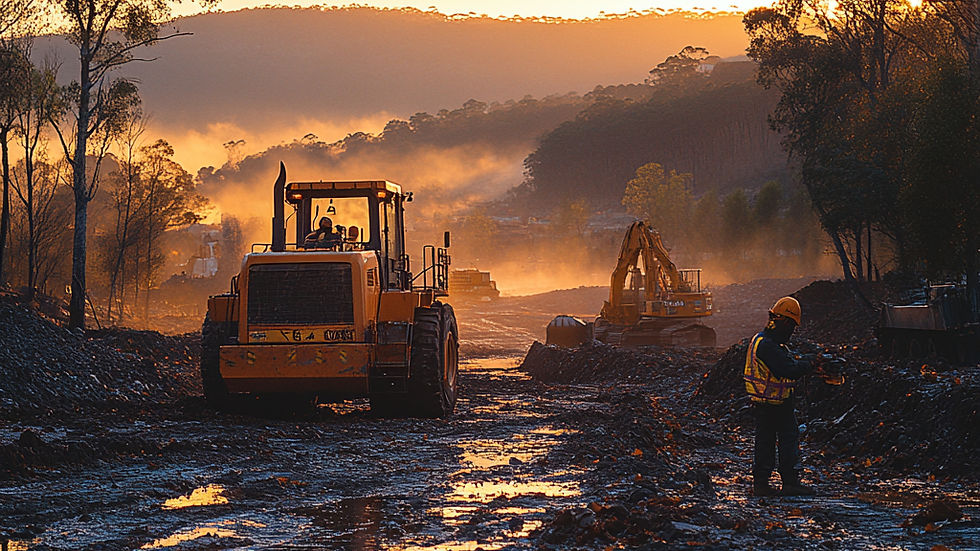Optimum Moisture Content for First-Pass Compaction
- willie746
- Sep 2
- 3 min read

You’ve got the right roller, the right crew, and the site’s ready to go, so why does the compaction test keep failing?
Every failed density test costs time, fuel, and patience. And more often than not, the problem isn’t your machine, it’s the moisture in the soil. Before you fire up that first pass, here’s what you need to know about getting the water content just right. At WNR Plant Hire, we supply site‑ready padfoot and smooth drum rollers, along with water trucks across Johannesburg and Gauteng, helping contractors hit optimum moisture content fast and keep projects moving.
If your compaction fails, it’s probably not the roller; it’s the water. The right moisture content is the difference between a dense, stable base and hours of costly rework. On construction sites in Johannesburg, Gauteng, and across South Africa, nailing that percentage early in the job is one of the smartest moves a contractor can make. With the right roller hire and water truck hire support, you can get it right the first time.
What is Optimum Moisture Content (OMC)?
Optimum Moisture Content (OMC) is the moisture level at which soil can be compacted to its maximum density with the least effort. Think of it as the ‘sweet spot’ where soil particles are lubricated just enough to move into a tighter formation under compaction, without being so wet that water takes up space where soil should be.
South African Standards & Soil Types
In South Africa, compaction work generally follows SANS 1200 specifications, which set out density and moisture requirements for different applications.
Our soils vary from high‑plasticity clays to loose sands, each with its own OMC range.
Clay soils often need higher moisture percentages (up to 20%), while sandy soils achieve OMC at much lower levels (around 8–12%). Local knowledge matters; what works in Gauteng’s clay won’t match the conditions in coastal sand.
The Risks of Getting it Wrong
Too dry, and the soil won’t knit together, leaving voids and weak spots that fail under load.
Too wet, and water fills the gaps, reducing density and stability. Both lead to rework, missed deadlines, and potential penalties. It’s not just about passing a compaction test, it’s about building a base that lasts.
How to Measure Moisture On‑Site
Lab testing is the gold standard, but field checks keep you on track day‑to‑day. Common methods include nuclear density gauges, speedy moisture testers, and even simple hand‑feel tests.
A quick field check can tell you if you’re in the ballpark before you commit to full passes.
Water Trucks & Compaction Gear
Adding or removing moisture is a balancing act. A well‑timed water truck pass can bring soil into its optimum range before the first roller pass. Inversely, over‑wet material may need to be aerated by scarifying before compaction.
Matching the right compactor, padfoot for clay, smooth drum for granular soils, to your moisture level makes each pass more effective.
First Pass Best Practices
Your first pass sets the tone for density. Work in overlapping strips, maintain consistent speed, and adjust vibration settings based on soil type and moisture. Re‑check moisture if conditions change; a hot, dry afternoon can shift your readings significantly.
Case Example: Gauteng Roadworks
On a recent Gauteng roadworks job, a contractor reduced rework by 30% simply by controlling moisture content before starting compaction. By coordinating water truck timing and roller passes, they hit target density on the first attempt, saving fuel, time, and client frustration.
How WNR Plant Hire Supports This
We supply site‑ready padfoot and smooth drum rollers, water trucks, and the practical know‑how to keep your compaction on spec from the first pass. Our team understands South African soils and works with you to match the right equipment to your site conditions.
Ready to Pass on the First Try?
Moisture control isn’t a nice-to-have; it’s the make-or-break factor for hitting density on the first pass. Get it right, and your crew stays productive, your project stays on schedule, and your base stays strong for years to come.
WNR Plant Hire has the rollers, water trucks, and on-the-ground know-how to make it happen anywhere in Johannesburg or Gauteng. Let’s get the right kit on your site before the next test.




Comments